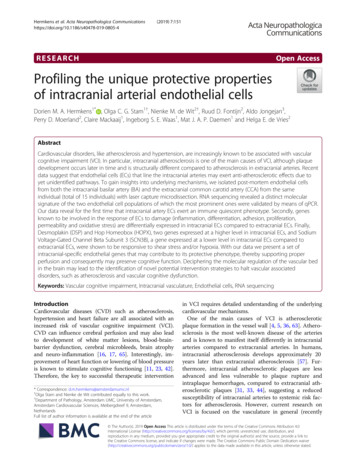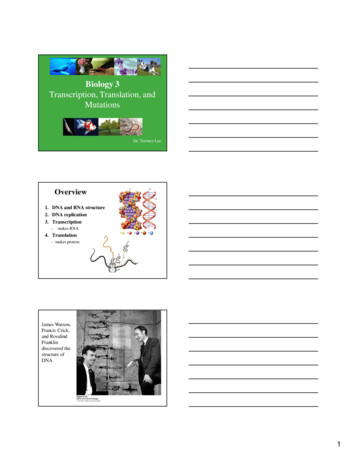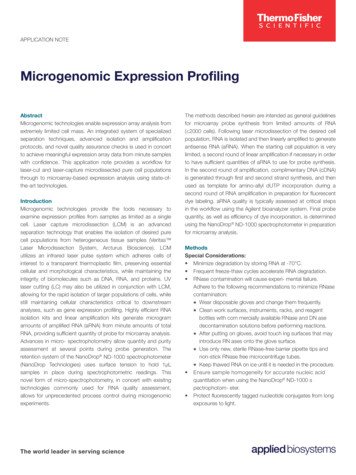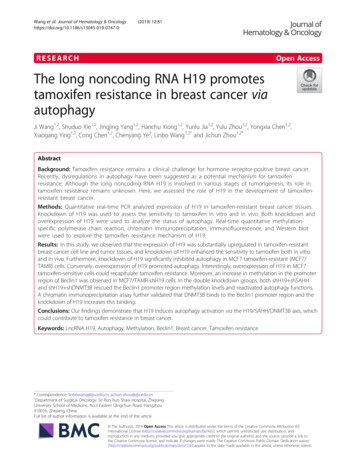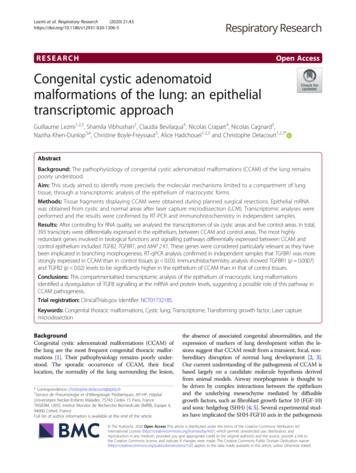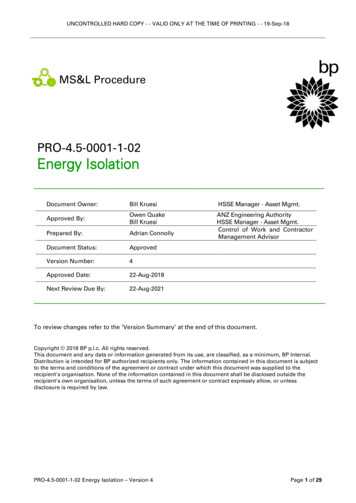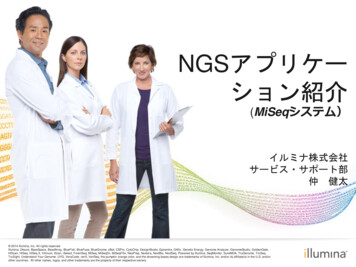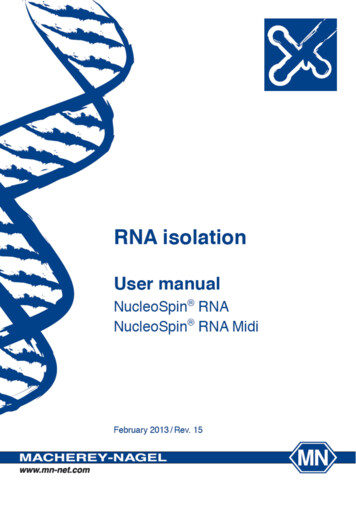
Transcription
RNA isolationTable of contents12Components51.1 Kit contents51.2 Reagents, consumables, and equipment to be supplied by user71.3 About this user manual7Product description82.1 The basic principle82.2 Kit specifications92.3 Handling, preparation, and storage of starting materials132.4 Elution procedures143Storage conditions and preparation of working solutions154Safety instructions174.1 Risk and safety phrases174.2 GHS classification18NucleoSpin RNA protocols2055.1 RNA purification from cultured cells and tissue205.2 RNA preparation from biological fluids(e.g., serum, culture medium)245.3 RNA preparation from up to 109 bacterial cells2575.4 RNA preparation from up to 5 x 10 yeast cells65.5 RNA preparation from paraffin embedded tissue*295.6 Clean-up of RNA from reaction mixtures30NucleoSpin RNA Midi protocols316.1 RNA purification from cultured cells and tissue9727316.2 RNA preparation from up to 5 x 10 bacterial cells356.3 RNA preparation from up to 3 x 108 yeast cells366.4 Clean-up of RNA from reaction mixtures38NucleoSpin RNA / NucleoSpin RNA Midi protocols39 7.1 RNA preparation from RNAlater treated samples397.2 rDNase digestion in solution40MACHEREY-NAGEL – 02 / 2013, Rev. 153
RNA isolation84Appendix428.1 Troubleshooting428.2 Ordering information458.3 Product use restriction / warranty46MACHEREY-NAGEL – 02 / 2013, Rev. 15
RNA isolation1Components1.1Kit contentsNucleoSpin RNA10 preps50 preps250 preps740955.10740955.50740955.250Lysis Buffer RA110 mL25 mL125 mLWash Buffer RAW215 mL15 mL80 mLWash Buffer RA3(Concentrate)*6 mL12.5 mL3 x 25 mLMembrane Desalting BufferMDB10 mL25 mL125 mLReaction Buffer for rDNase3 mL7 mL30 mL1 vial(size D)1 vial(size F)5 vials(size F)15 mL15 mL125 mLNucleoSpin Filters (violetrings)1050250NucleoSpin RNA Columns(light blue rings – plusCollection Tubes)1050250Collection Tubes (2 mL)30150750Collection Tubes (1.5 mL)1050250User manual111REFrDNase, RNase-free(lyophilized)*RNase-free H2O* For preparation of working solutions and storage conditions see section 3.MACHEREY-NAGEL – 02 / 2013, Rev. 155
RNA isolation1.1Kit contents continuedNucleoSpin RNA Midi20 prepsREF740962.20Lysis Buffer RA180 mLWas Buffer RAW260 mLWash Buffer RA3 (Concentrate)*25 mLMembrane Desalting Buffer MDB50 mLReaction Buffer for rDNase7 mLrDNase, RNase-free (lyophilized)*RNase-free H2O1 vial (size D)15 mLNucleoSpin Filters Midi(plus Collection Tubes)20NucleoSpin RNA Midi Columns(plus Collection Tubes)20Collection Tubes (15 mL)20User manual1* For preparation of working solutions and storage conditions see section 3.6MACHEREY-NAGEL – 02 / 2013, Rev. 15
RNA isolation1.2Reagents, consumables, and equipment to be suppliedby userReagents 96–100 % ethanol (to prepare Wash Buffer RA3)70 % ethanol (to adjust RNA binding conditions)Reducing agent (ß-mercaptoethanol, or DTT (dithiothreithol), or TCEP thyl)-methane)) as supplement forLysis Buffer RA1Consumables 1.5 mL microcentrifuge tubes (NucleoSpin RNA) or 15 mL tubes (NucleoSpin RNA Midi)Sterile RNase-free tipsEquipment Manual pipettors Equipment for sample disruption and homogenization (see section 2.3) 1.3NucleoSpin RNA: centrifuge for microcentrifuge tubesNucleoSpin RNA Midi: centrifuge for 15 mL tubes with a swing-out rotor andappropriate buckets capable of reaching 4,000–4,500 x gPersonal protection equipment (e.g., lab coat, gloves, goggles)About this user manualIt is strongly recommended reading the detailed protocol sections of this user manualif the NucleoSpin RNA or NucleoSpin RNA Midi kit is used for the first time.Experienced users, however, may refer to the Protocol-at-a-glance instead. TheProtocol-at-a-glance is designed to be used only as a supplemental tool for quickreferencing while performing the purification procedure.All technical literature is available on the internet at www.mn-net.com.Please contact Technical Service regarding information about changes of the currentuser manual compared to previous revisions.MACHEREY-NAGEL – 02 / 2013, Rev. 157
RNA isolation2Product description2.1The basic principleOne of the most important aspects in the isolation of RNA is to prevent degradation ofthe RNA during the isolation procedure. With the NucleoSpin RNA methods, cellsare lysed by incubation in a solution containing large amounts of chaotropic ions. Thislysis buffer immediately inactivates RNases – which are present in virtually all biologicalmaterials – and creates appropriate binding conditions which favor adsorption of RNA tothe silica membrane. Contaminating DNA, which is also bound to the silica membrane,is removed by an rDNase solution which is directly applied onto the silica membraneduring the preparation (RNase-free rDNase is supplied with the kit). Simple washingsteps with two different buffers remove salts, metabolites and macromolecular cellularcomponents. Pure RNA is finally eluted under low ionic strength conditions with RNasefree H2O (supplied).The RNA preparation using NucleoSpin RNA kits can be performed at roomtemperature. The eluate, however, should be treated with care because RNA isvery sensitive to trace contaminations of RNases, often found on general lab ware,fingerprints and dust. To ensure RNA stability keep RNA frozen at -20 C for short-termor -70 C for long-term storage.Simultaneous isolation of RNA, Protein, and DNA (NucleoSpin RNA /DNABuffer Set*, NucleoSpin TriPrep*)ökölkölkThe NucleoSpin RNA / DNA Buffer Set (see ordering information) is a support set forRNA and DNA isolation in conjunction with NucleoSpin RNA, NucleoSpin RNA XS,NucleoSpin RNA Plant, or NucleoSpin RNA / Protein.This patented technology enables successive elution of DNA and RNA from oneNucleoSpin Column with low salt buffer and water respectively. DNA and RNA areimmediately ready for downstream applications.The combination of the NucleoSpin RNA / DNA Buffer Set with NucleoSpin RNA /Protein allows parallel isolation of RNA, DNA, and protein from one undivided sample.The NucleoSpin TriPrep kit features the purification of RNA, DNA, and protein fromsingle undivided samples.* DISTRIBUTION AND USE OF NUCLEOSPIN RNA / DNA BUFFER SET AND NUCLEOSPIN TRIPREP INTHE USA IS PROHIBITED FOR PATENT REASONS.8MACHEREY-NAGEL – 02 / 2013, Rev. 15
RNA isolation2.2Kit specifications NucleoSpin RNA kits are recommended for the isolation of RNA fromcultured cells and tissue. Support protocols for the isolation of RNA from cellfree biological fluids, bacteria, and yeasts using the NucleoSpin RNA kit areincluded. The NucleoSpin RNA kits allow purification of pure RNA with anA260 / A280 ratio generally exceeding 1.9 (measured in TE buffer, pH 7.5). Even biological samples which are sometimes difficult to process will yieldhigh quality RNA. Such samples are, for example, mouse tissue (liver, brain),different tumor cell lines, Streptococci, and Actinobacillus pleuropneumoniae. The isolated RNA is ready to use for applications like reverse transcriptasePCR (RT-PCR), primer extension, or RNase protection assays. RNA isolated with NucleoSpin RNA kits is of high integrity. RIN (RNA IntegrityNumber) of RNA isolated from fresh high quality sample material (e.g.,eukaryotic cells or fresh mouse liver) generally exceeds 9.0. However, RNAintegrity strongly depends on the sample quality. RNA integrity was examinedusing the Agilent 2100 Bioanalyzer in conjunction with the RNA 6000 Nano orPico assay. The amount of DNA contamination is significantly reduced during on-columndigestion with rDNase. Anyhow, in very sensitive applications it might be possibleto detect traces of DNA. The NucleoSpin RNA on-column DNA removal istested with the following procedure: One million HeLa cells are subjected toRNA isolation according to the protocol. RNA eluate is used as template forPCR detection of a 1 kb fragment in a 30 cycle reaction. Generally no PCRfragment is obtained if the DNase is applied while a strong PCR fragment maybe obtained if the DNase digestion is omitted. The probability of DNA detectionwith PCR increases with:1. the number of DNA copies per preparation: single copy target plastidial /mitochondrial target plasmid transfected into cells.2. decreasing PCR amplicon size.MACHEREY-NAGEL – 02 / 2013, Rev. 159
RNA isolationTable 1: Kit specifications at a glanceParameterNucleoSpin RNANucleoSpin RNA MidiTechnologySilica-membrane technolgySilica-membrane technolgyMini spin columnMidi spin column 5 x 106 cultured cells, 109 bacterial cells, 108 yeast cells, 30 mg tissue 5 x 107 cultured cells, 1010 bacterial cells, 3 x 108 yeast cells, 200 mg tissue 200 b 200 bFormatSample materialFragment size14 μg from 10 HeLa cells,70 μg from 109 bacterial cells180 μg from 107 HeLa cells,620 μg from 4 x 107 HeLa cells1.9–2.11.9–2.1 9 940–120 μL500 μLPreparation time30 min/6 preps80 min/4 prepsBinding capacity200 μg700 μgTypical yieldA260/A280Typical RIN (RNAintegrity number)Elution volume6NucleoSpin RNA10 The standard protocol (section 5.1) allows the purification of up to 70 μg RNAper NucleoSpin RNA Column from up to 5 x 106 cultured cells or 30 mg oftissue (also see Table 1). The isolated RNA can be used as template in a RTPCR-reaction. Generally, 1–10 % of the eluate of RNA prepared from 1 x 106cells or 10 mg of tissue is sufficient as template for RT-PCR. If possible, intronspanning primers should be used for RT-PCR. The RNA prepared from such high amounts is generally free of residual DNA,although minute traces of DNA may remain in the preparation, if large amountsof material rich in nucleic acids are used. However, if the isolated RNA will beused as template in a RT-PCR-reaction, we recommend to use lower quantitiesof sample (e.g., 1 x 106 cultured cells or 10 mg of tissue resulting in about 20 μgof RNA). The kit can be used for preparing RNA from different amounts of samplematerial. For optimal results the volume of Lysis Buffer RA1 (protocol step 1)and of ethanol (protocol step 3) should be adapted according to Table 2.MACHEREY-NAGEL – 02 / 2013, Rev. 15
RNA isolationTable 2: Lysis adaptationSampleAmountVolume ofLysis Buffer RA1(protocol step 2)Ethanol(protocol step 4) 5 x 106350 μL350 μLHuman oranimal tissue 20 mg20 mg–30 mg*350 μL600 μL350 μL600 μLTissue storedin RNAlater 20 mg20 mg–30 mg*350 μL600 μL350 μL600 μL 5 x 107*600 μL600 μLCultured animalor human cells(e.g., HeLa cells)Samples knownto be hard to lyseAn additional loading step is required if 600 μL Buffer RA1 and ethanol is used (loadthe sample onto the column in two successive centrifugation steps). Depending on sample type, the average yield is around 5–70 μg RNA (seeTable 3). The A260 / A280 ratio generally exceeds 1.9, indicating purity of the RNA.Table 3: Overview on average yields of RNA isolation usingNucleoSpin RNASample4Average yield8 x 10 HeLa cells1.5 μg4 x 105 HeLa cells4 μg1 x 106 HeLa cells14 μg621 μg62.5 x 10 HeLa cells25 μg5 x 106 HeLa cells50 μg2 x 10 HeLa cells* The volume of Lysis Buffer RA1 included in the kit is not sufficient to perform all preparations with 600 μL.If required, additional Lysis Buffer RA1 can be ordered separately (see ordering information).MACHEREY-NAGEL – 02 / 2013, Rev. 1511
RNA isolationNucleoSpin RNA Midi The kit can be used for preparing RNA from different amounts of samplematerial. For optimal results the volume of Lysis Buffer RA1 (protocol step 1)and of ethanol (protocol step 3) should be adapted according to table 4:Table 4: Lysis adaptationSampleAmountCultured animal cells(e.g., HeLa cells)Animal tissueBacteriaYeastVolume ofLysis Buffer RA1(protocol step 1)Ethanol(protocol step 4)5 x 106–2 x 1072 x 107–5 x 1071.8 mL3.6 mL1.8 mL3.6 mL30–100 mg100– 200 mg1.8 mL3.6 mL1.8 mL3.6 mL1 x 109–5 x 1092 x 109–1 x 10101.8 mL3.6 mL1.8 mL3.6 mL 3 x 1083.6 mL3.6 mL An additional loading step is required if 3.6 mL Buffer RA1 and ethanol is used. Ifyou isolate RNA from a certain kind of tissue the first time with the NucleoSpin RNA Midi kit, we recommend starting with no more than 100 mg of tissue.Depending on the nature of the tissue, up to 200 mg can be processed. Do notuse more than 200 mg of tissue to avoid clogging of the column. Depending on sample type, the average yield is around 70–400 μg RNA (seetable 5). The A260 / A280 ratio indicating purity of the RNA generally exceeds 1.9.Table 5: Overview on average yields of RNA isolation usingNucleoSpin RNA MidiSample20 μg71 x 10 HeLa cells160 μg2 x 107 HeLa cells330 μg4 x 107 HeLa cells620 μg200 mg pig liver450 μg200 mg mouse liver320 μg1 x 10 HeLa cells12Average yield6MACHEREY-NAGEL – 02 / 2013, Rev. 15
RNA isolation2.3Handling, preparation, and storage of starting materialsRNA is not protected against digestion until the sample material is flash frozen ordisrupted in the presence of RNase inhibiting or denaturing agents. Therefore it isimportant that samples are flash frozen in liquid N2 immediately and stored at -70 C orprocessed as soon as possible. Frozen samples are stable up to 6 months. Samplescan be stored in Lysis Buffer RA1 after disruption at -70 C for up to one year, at 4 Cfor up to 24 hours or up to several hours at room temperature. Frozen samples in BufferRA1 should be thawed slowly before starting with the isolation of RNA.Wear gloves at all times during the preparation. Change gloves frequently.Cultured animal cells are collected by centrifugation and directly lysed by addingBuffer RA1 according to step 2 of the standard protocol (see sections 5.1, 5.6).Cell lysis of adherent growing cells in a culture dish:Completely aspirate cell-culture medium, and continue immediately with the addition ofLysis Buffer RA1 to the cell-culture dish. Avoid incomplete removal of the cell-culturemedium in order to allow full lysis activity of the lysis buffer.To trypsinize adherent growing cells:Aspirate cell-culture medium, and add an equal amount of PBS in order to wash thecells. Aspirate PBS. Add 0.1–0.3 % trypsin in PBS and incubate for an appropriate timeto detach the cells from the dish surface. After cell detachment, add medium, transfercells to an appropriate tube (not supplied), and pellet by centrifugation for 5 min at300 x g. Remove supernatant and continue with the addition of lysis buffer to the cellpellet.Animal tissues are often solid and must therefore be broken up mechanically as wellas lysed. Depending on the disruption method, the viscosity of the lysed sample has tobe reduced further for optimal results. It is essential for efficient RNA preparation thatall the RNA contained in the sample is released from the cells by disruption and that theviscosity of the sample is reduced by homogenization.The most commonly used technique for disruption of animal tissues is grinding with apestle and mortar. Grind the sample to a fine powder in the presence of liquid N2. Takecare that the sample does not thaw during or after grinding or weighing and add thefrozen powder to an appropriate aliquot of Buffer RA1 containing reducing agent, (e.g.,ß-mercaptoethanol, DTT, or TCEP) and mix immediately. The broken-up tissue mustthen be homogenized with a NucleoSpin Filter / Filter Midi (included in the kit) or bypassing 5 times through a 0.9 mm syringe needle.Thawing of undisrupted animal tissue should be exclusively done in the presenceof Buffer RA1 during simultaneous mechanical disruption, for example, with arotor-stator homogenizer. This ensures that the RNA is not degraded by RNasesbefore the preparation has started. The spinning rotor disrupts and simultaneouslyhomogenizes the sample by mechanical shearing of DNA within seconds up to minutesMACHEREY-NAGEL – 02 / 2013, Rev. 1513
RNA isolation(homogenization time depends on sample). Take care to keep the rotor tip submergedin order to avoid excess foaming. Select a suitably sized homogenizer (5–7 mmdiameter rotors can be used for homogenization in microcentrifuge tubes).Bacteria and yeasts have to be incubated in lysozyme or lyticase / zymolasesolutions, respectively (see support protocols in section 5). By this treatment, the robustcell walls of these organisms are digested or at least weakened, which is essentialfor effective cell lysis by Buffer RA1. For microorganisms with extremely resistant cellwalls – like some Gram-positive bacterial strains – it may be necessary to optimize theconditions of the treatment with lytic enzymes or the cultivation conditions. After lysis,homogenization is achieved by the use of a NucleoSpin Filter or the syringe-needlemethod.2.4Elution proceduresIt is possible to adapt elution method and volume of water used for the subsequentapplication of interest. In addition to the standard method described in the individualprotocols (recovery rate about 70–90 %) there are several modifications possible. High yield: Perform two elution steps with the volume indicated in the individualprotocol. About 90–100 % of bound nucleic acid will be eluted. High yield and high concentration: Elute with the standard elution volumeand apply the eluate once more onto the column for reelution.Eluted RNA should immediately be put and always kept on ice for optimal stabilitybecause almost omnipresent RNases (general lab ware, fingerprints, dust) will degradeRNA. For short-term storage freeze at -20 C, for long-term storage freeze at -70 C.14MACHEREY-NAGEL – 02 / 2013, Rev. 15
RNA isolation3Storage conditions and preparation of workingsolutionsAttention:Buffers RA1, RAW2, and MDB contain chaotropic salt. Wear gloves and goggles!CAUTION: Buffers RA1, RAW2 and MDB contain chaotropic salt which can form highlyreactive compounds when combined with bleach (sodium hypochlorite). DO NOT addbleach or acidic solutions directly to the sample-preparation waste. Store lyophilized rDNase (RNase-free) at 4 C on arrival (stable up to 1 year). All other kit components should be stored at room temperature (18–25 C)and are stable for at least one year. Storage at lower temperatures may causeprecipitation of salts. Check that 70 % ethanol is available as additional solution to adjust RNAbinding conditions in the lysate. Check that reducing agent (ß-ME, DTT, or TCEP) is available.Before starting any NucleoSpin RNA protocol, prepare the following: rDNase (RNase-free): Add indicated volume of RNase-free H2O (see tablebelow) to the rDNase vial and incubate for 1 min at room temperature. Gentlyswirl the vials to completely dissolve the rDNase. Be careful not to mix rDNasevigorously as rDNase is sensitive to mechanical agitation. Dispense intoaliquots and store at -20 C. The frozen working solution is stable for at least6 months. Do not freeze / thaw the aliquots more than three times. (Be carefulwhen opening the vial as some particles of the lyophilisate may be attached tothe lid.)In some cases the vial of rDNase may appear empty. This is due to lyophilizedenzyme sticking to the septum. To avoid loss of rDNase, make sure to collectrDNase on the bottom of the vial before removing the plug. Alternatively, injectRNase-free water into the vial using a needle and syringe, invert the vial todissolve the rDNase, and remove the dissolved rDNase using syringe andneedle. Wash Buffer RA3: Add the indicated volume of 96–100 % ethanol (see tablebelow) to Buffer RA3 Concentrate. Mark the label of the bottle to indicate thatethanol was added. Wash Buffer RA3 can be stored at room temperature (18–25 C) for at least one year.MACHEREY-NAGEL – 02 / 2013, Rev. 1515
RNA isolationNucleoSpin RNAREFWash Buffer RA3(Concentrate)rDNase, RNase-free(lyophilized)10 preps50 preps250 preps740955.10740955.50740955.2506 mL12.5 mLAdd 24 mL ethanol Add 50 mL ethanol1 vial (size D)Add 120 μLRNase-free H2O1 vial (size F)Add 550 μLRNase-free H2O3 x 25 mLAdd 100 mLethanolto each vial5 vials (size F)Add 550 μLRNase-free H2Oto each vialNucleoSpin RNA Midi20 prepsREF740962.20Wash Buffer RA3 (Concentrate)rDNase, RNase-free (lyophilized)1625 mLAdd 100 mL ethanol1 vial (size D)Add 540 μL RNase-free H2OMACHEREY-NAGEL – 02 / 2013, Rev. 15
RNA isolation4Safety instructionsThe following components of the NucleoSpin RNA and NucleoSpin RNA Midi kitscontain hazardous contents.Wear gloves and goggles and follow the safety instructions given in this section.4.1Risk and safety phrasesComponent Hazard ,RNase-freerDNase, lyophilizedXnR 42/43S 22-24RA1Guanidinium thiocyanate 30–60 %Xn*R 20/21/2232-52/53S 13-61RAW2Guanidine hydrochloride 24–36 % ethanol 20-35 %Xn*R 10-22S 16Guanidinium thiocyanate 1–15 % ethanol 5–20 %*R 10rDNase, lyophilisiertGuanidiniumthiocyanat 30–60 %Guanidinhydrochlorid 24–36 % Ethanol 20–35 %MDBGuanidiniumthiocyanat 1–15 % Ethanol 5–20 %Risk phrasesR 10Flammable.R 20/21/22Harmful by inhalation, in contact with skin and if swallowed.R 22Harmful if swallowed.R 42/43May cause sensitization by inhalation and skin contactR 52/53Harmful to aquatic organisms, may cause long-term adverse effects in theaquatic environment.Entzündlich.Gesundheitsschädlich beim Einatmen, Verschlucken und Berührung mit der Haut.Gesundheitsschädlich beim Verschlucken.Sensibilisierung durch Einatmen und Hautkontakt möglich.Schädlich für Wasserorganismen, kann in Gewässern längerfristig schädliche Wirkungenhaben.* Hazard labeling not neccessary if quantity per bottle below 125 g or mL (certificate of exemptionaccording to 67/548/EEC Art. 25, 1999/45/EC Art. 12 and German GefStoffV § 20 (3) and TRGS 200 7.1).For further information see Material Safety Data Sheet.MACHEREY-NAGEL – 02 / 2013, Rev. 1517
RNA isolation Safety phrasesS 13Keep away from food, drink and animal foodstuffs.S 16Keep away from sources of ignition – No smoking.S 22Do not breathe dust.S 24Avoid contact with the skin.S 61Avoid release to the environment. Refer to special instructions / safety data sheet.4.2Von Nahrungsmitteln, Getränken und Futtermitteln fernhalten.Von Zündquellen fernhalten – Nicht rauchen!Staub nicht einatmen.Berührung mit der Haut vermeiden.Freisetzung in die Umwelt vermeiden. Besondere Anweisungen einholen / Sicherheitsdatenblätter zu Rate ziehen.GHS classificationOnly harmful features do not need to be labeled with H and P phrases until 125 mL or125 g.Mindergefährliche Eigenschaften müssen bis 125 mL oder 125 g nicht mit H- und P-Sätzen gekennzeichnetwerden.Component Hazard contentsGHS symbolHazard Precautionphrases phrasesInhaltGefahrstoffGHS SymbolH-SätzeP-SätzerDNase,RNase-freerDNase, lyophilizedDanger317, 334261, 280,302 352,304 341,333 313,342 311, 363RA1Guanidinium thiocyanate30–60 %WarningGuanidiniumthiocyanat30–60 %Achtung302, 412,EUH031260, 273,301 312, 330Guanidine hydrochloride24–36 % ethanol 2035 %Warning226, 302,Guanidinhydrochlorid 24–36 % Ethanol 20–35 %Achtung210, 233,301 312, 330,403 235Guanidinium thiocyanate1–15 % ethanol 5–20 %Warning226210, 233,403 235RAW2MDBrDNase, lyophilisiertGuanidiniumthiocyanat 1–15 % Ethanol 5–20 %GefahrAchtungHazard phrasesH 226Flammable liquid and vapour.H 302Harmful if swallowed.H 317May cause an allergic skin reaction.18Flüssigkeit und Dampf entzündbar.Gesundheitsschädlich bei Verschlucken.MACHEREY-NAGEL – 02 / 2013, Rev. 15
RNA isolationHazard phrasesKann allergische Hautreaktionen verursachen.H 334May cause allergy or asthma symptoms or breathing difficulties if inhaled.H 412Harmful to aquatic life with long lasting effects.EUH031Contact with acids liberates toxic gas.Kann bei Einatmen Allergie, asthmaartige Symptome oder Atembeschwerden verursachen.Schädlich für Wasserorganismen, mit langfristiger Wirkung.Entwickelt bei Berührung mit Säure giftige Gase.Precaution phrasesP 210Keep away from heat / sparks / open flames / hot surfaces – No smoking.P 233Keep container tightly closedP 260Do not breathe vapours.P 261Avoid breathing dust.P 273Avoid release to the environment.P 280Wear protective gloves / eye protection.P 301 312IF SWALLOWED: Call a POISON CENTER or doctor /physician if you feelunwell.P 302 352IF ON SKIN: Wash with plenty of soap and water.P 304 341IF INHALED: If breathing is difficult, remove to fresh air and keep at rest in aposition comfortable for breathing.Von Hitze / Funken / offener Flamme / heißen Oberflächen fernhalten.Behälter dicht verschlossen halten.Dampf nicht einatmen.Einatmen von Staub vermeiden.Freisetzung in die Umwelt vermeiden.Schutzhandschuhe / Augenschutz tragen.BEI VERSCHLUCKEN: Bei Unwohlsein GIFTINFORMATIONSZENTRUM oder Arzt anrufen.BEI KONTAKT MIT DER HAUT: Mit viel Wasser und Seife waschen.BEI EINATMEN: Bei Atembeschwerden an die frische Luft bringen und in einer Positionruhigstellen, die das Atmen erleichtert.P 330Rinse mouth.P 333 313IF skin irritation or a rash occurs: Get medical advice / attention.P 342 311If experiencing respiratory symptoms: Call a POISON CENTER or doctor / physician.P 403 235Store in a well ventilated place. Keep cool.P 363Wash contaminated clothing before reuse.Mund ausspülen.Bei Hautreizung oder -ausschlag: Ärztlichen Rat einholen / ärztliche Hilfe hinzuziehen.Bei Symptomen der Atemwege: GIFTINFORMATIONSZENTRUM oder Arzt anrufen.Kühl an einem gut belüfteten Ort augbewahren.Kontaminierte Kleidung vor erneutem Tragen waschen.For further information please see Material Safety Data Sheets (www.mn-net.com).Weiterführende Informationen finden Sie in den Sicherheitsdatenblättern (www.mn-net.com).MACHEREY-NAGEL – 02 / 2013, Rev. 1519
NucleoSpin RNA7Digest DNAPrepare DNase reaction mixture in a sterile 1.5 mLmicrocentrifuge tube (not provided): For each isolation,add 10 μL reconstituted rDNase (also see section 3) to90 μL Reaction Buffer for rDNase. Mix by flicking thetube.Apply 95 μL DNase reaction mixture directly onto thecenter of the silica membrane of the column. Incubate atroom temperature for 15 min.8 95 μLrDNasereactionmixtureRT,15 minWash and dry silica membrane 200 μL RAW21st washAdd 200 μL Buffer RAW2 to the NucleoSpin RNAColumn. Centrifuge for 30 s at 11,000 x g. Place thecolumn into a new Collection Tube (2 mL).11,000 x g,30 sBuffer RAW2 will inactivate the rDNase.2nd washAdd 600 μL Buffer RA3 to the NucleoSpin RNAColumn. Centrifuge for 30 s at 11,000 x g. Discard flowthrough and place the column back into the CollectionTube.Note: Make sure that residual buffer from the previous stepsis washed away with Buffer RA3, especially if the lysatehas been in contact with the inner rim of the column duringloading of the lysate onto the column. For efficient washingof the inner rim flush it with Buffer RA3. 600 μL RA311,000 x g,30 s3rd washAdd 250 μL Buffer RA3 to the NucleoSpin RNAColumn. Centrifuge for 2 min at 11,000 x g to dry themembrane completely. Place the column into a nucleasefree Collection Tube (1.5 mL, supplied).If for any reason, the liquid level in the Collection Tube hasreached the NucleoSpin RNA Column after centrifugation,discard flow-through, and centrifuge again.22MACHEREY-NAGEL – 02 / 2013, Rev. 15 250 μL RA311,000 x g,2 min
NucleoSpin RNA5.2RNA preparation from biological fluids(e.g., serum, culture medium)Before starting the preparation: 1Check if Wash Buffer RA3 and rDNase were prepared according to section 3.Homogenize sampleNot necessary!2Lyse sampleAdd 350 μL Buffer RA1 and 3.5 μL ß-mercaptoethanol to 100 μL of sampleand vortex vigorously.For appropriate sample and lysis buffer amounts see section 2.2.Note: As alternative to ß-ME the reducing agent DTT or TCEP may be used. Use afinal concentration of 10–20 mM DTT or TCEP within the Lysis Buffer RA1.3Filtrate lysateNot necessary!4Adjust RNA binding conditionsAdd 350 μL of ethanol (70 %) to the lysate and mix by vortexing.Proceed with step 5 of the NucleoSpin RNA standard protocol (section 5.1).24MACHEREY-NAGEL – 02 / 2013, Rev. 15
NucleoSpin RNA5.3RNA preparation from up to 109 bacterial cellsAdditional reagent to be supplied by user: LysozymeBefore starting the preparation: 1Check if Wash Buffer RA3 and rDNase were prepared according to section 3.Homogenize sampleResuspend the bacterial cell pellet (Gram-negative strains) in 100 μL TEbuffer (10 mM Tris-HCl, 1 mM EDTA; pH 8) containing 1 mg/mL lysozyme byvigorous vortexing. Incubate at 37 C for 10 min.For preparation of RNA from Gram-positive bacteria, resuspend cells in 100 μL TEcontaining 2 mg/mL lysozyme. It may be necessary to optimize incubation time andlysozyme concentration, depending on the bacterial strain.Note: Due to the much higher concentration of genome equivalents in a nucleic acidpreparation of bacteria compared with eukaryotic material, it may be necessary to usea lower quantity of cells for the preparation.2Lyse cellsAdd 350 μL Buffer RA1 and 3.5 μL ß-mercaptoethanol to the suspension andvortex vigorously.For appropriate sample and lysis buffer amounts see section 2.2.Note: As alternative to ß-ME the reducing agent DTT or TCEP may be used. Use afinal concentration of 10–20 mM DTT or TCEP within the Lysis Buffer RA1.3Filtrate lysateReduce viscosity and turbidity of the solution by filtration through NucleoSpin Filters (violet rings). Place NucleoSpin Filters in Collection Tubes (2 mL),apply mixture, and centrifuge for 1 min at 11,000 x g.In case of visible pellet formation (depending on sample amount and nature) transfersupernatant without any formed pellet to a new 1.5 mL microcentrifuge tube (notsupplied).Alternatively, the lysate may be passed 5 times through a 0.9 mm needle (20 gauge)fitted to a syringe.MACHEREY-NAGEL – 02 / 2013, Rev. 1525
NucleoSpin RNA4Adjust RNA binding conditionsAdd 350 μL of ethanol (70 %) to the lysate and mix by vortexing.Proceed with step 5 of the NucleoSpin RNA standard protocol (section 5.1).26MACHEREY-NAGEL – 02 / 2013, Rev. 15
NucleoSpin RNA5.4RNA preparation from up to 5 x 107 yeast cellsAdditional reagents and components to be supplied by user: Reducing agent (ß-mercaptoethanol, or DTT (dithiothreithol), or TCEP thyl)-meth
RNA isolation MACHEREY-NAGEL - 02 / 2013, Rev. 15 2.2 Kit specifications NucleoSpin RNA kits are recommended for the isolation of RNA from cultured cells and tissue. Support protocols for the isolation of RNA from cell-free biological fluids,bacteria, and yeasts using the NucleoSpin RNA kit are included.
